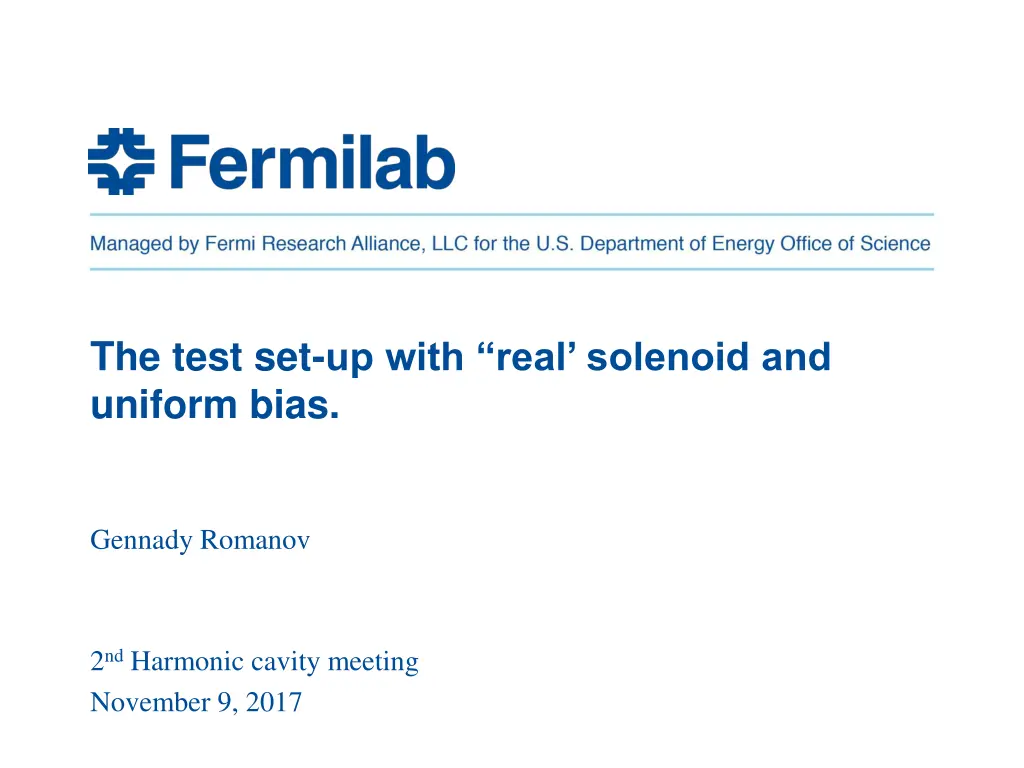
Solenoid Test Setup with Real Components
Explore the test setup with a real solenoid and uniform bias conducted by Gennady Romanov, focusing on the distribution of RF losses, results with fitted parameters, and non-linearity of H. Gain insights on the solenoid model, gyromagnetic resonance, and experimental frequencies.
Download Presentation

Please find below an Image/Link to download the presentation.
The content on the website is provided AS IS for your information and personal use only. It may not be sold, licensed, or shared on other websites without obtaining consent from the author. If you encounter any issues during the download, it is possible that the publisher has removed the file from their server.
You are allowed to download the files provided on this website for personal or commercial use, subject to the condition that they are used lawfully. All files are the property of their respective owners.
The content on the website is provided AS IS for your information and personal use only. It may not be sold, licensed, or shared on other websites without obtaining consent from the author.
E N D
Presentation Transcript
The test set-up with real solenoid and uniform bias. Gennady Romanov 2ndHarmonic cavity meeting November 9, 2017
Solenoid model Yoke d1 Ceramic Garnet Copper d2 Yoke Number of turns 224 d1>d2, may be the garnet should be flipped over? I solenoid = 5 A =2.9 6 H Lowest H 15000 A/m, while gyromagnetic resonance at 75 MHz is 2100 A/m 2 Gennady Romanov |The test set-up with real solenoid and uniform bias. 9/XI-2017
Distribution of RF losses at I_sol = 4.2 A Normal copper 5.8e7 S/m Garnet Al800_exp4 (our base model) Shown interval of losses is from 0.07 to 0.6 W/m3 3 Gennady Romanov |The test set-up with real solenoid and uniform bias. 9/XI-2017
Results with constant = 0.0036 (H = 24 Oe at f0 = 9.4 GHz) Empty 2215 1870 Frequency excellent agreement Q similar general behavior In the experiments the lowest Q is defined mostly by losses in the garnet Gyromagnetic resonance is well below lowest internal bias field. Non-linear (Hbias) ? - is integrated parameter, average over the disk volume, not a material characteristic. Losses in the garnet dominate 4 Gennady Romanov |The test set-up with real solenoid and uniform bias. 9/XI-2017
Results with fitted Hand two copper conductivities Q vs I_sol F vs I_sol 2500 130 120 2000 110 1500 F, MHz 100 Q 90 1000 Experiment 20171027 Normal copper, fitted dH Fitted copper, fitted dH, uniform H Normal copper, fitted dH Experiment 20171027 Fitted copper, fitted dH, uniform H 80 500 70 0 60 0 5 10 15 20 25 0 5 10 15 20 25 I_sol, A I_sol, A Normal copper, fitted H H was fitted to get experimental Q at low end and smoothly reach theoretical Q at high end with. Copper conductivity was kept constant (5.7e7 S/m). Fitted copper, fitted H, uniform H conductivity of copper was chosen to meet experimental Q of empty test set-up and then kept constant (4.7e7 S/m), H and uniform H were fitted to get experimental frequencies and Qs. 5 Gennady Romanov |The test set-up with real solenoid and uniform bias. 9/XI-2017
Non-linearity of H H fitted 80 Normal copper, fitted dH 70 Fitted copper, fitted dH, uniform H 60 H, Oe 50 40 30 20 0 5 10 15 20 25 I_sol, A 6 Gennady Romanov |The test set-up with real solenoid and uniform bias. 9/XI-2017
